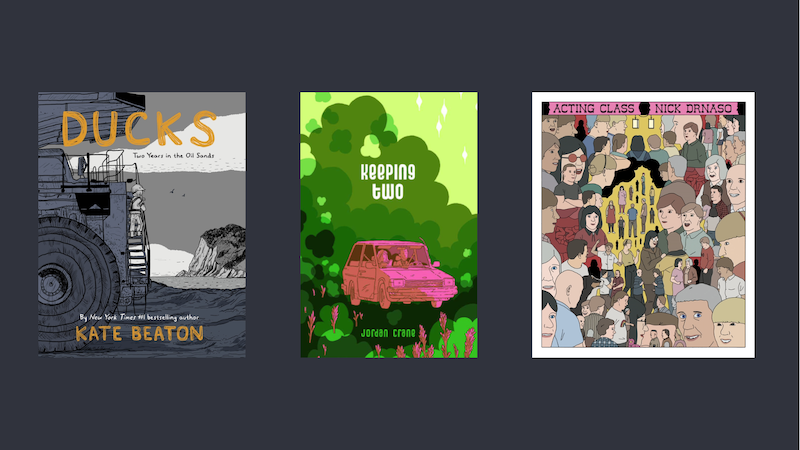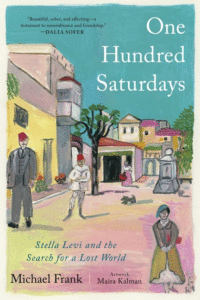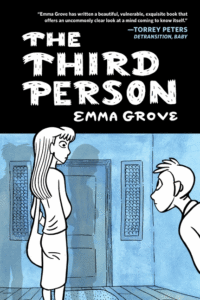
We’ve come to the end of another bountiful literary year, and for all of us review rabbits here at Book Marks, that can mean only one thing: basic math, and lots of it.
Yes, using reviews drawn from more than 150 publications, over the next two weeks we’ll be calculating and revealing the most critically-acclaimed books of 2022, in the categories of (deep breath): Fiction; Nonfiction; Memoir and Biography; Sci-Fi, Fantasy, and Horror; Short Story Collections; Essay Collections; Poetry; Mystery and Crime; Graphic Literature; and Literature in Translation.
Today’s installment: Graphic Novels & Graphic Nonfiction.
*
1. Ducks: Two Years in the Oil Sands by Kate Beaton
(Drawn & Quarterly)
14 Rave • 4 Positive
Watch an interview with Kate Beaton here
“It could hardly be more different in tone from [Beaton’s] popular larky strip Hark! A Vagrant … Yes, it’s funny at moments; Beaton’s low-key wryness is present and correct, and her drawings of people are as charming and as expressive as ever. But its mood overall is deeply melancholic. Her story, which runs to more than 400 pages, encompasses not only such thorny matters as social class and environmental destruction; it may be the best book I have ever read about sexual harassment … There are some gorgeous drawings in Ducks of the snow and the starry sky at night. But the human terrain, in her hands, is never only black and white … And it’s this that gives her story not only its richness and depth, but also its astonishing grace. Life is complex, she tell us, quietly, and we are all in it together; each one of us is only trying to survive. What a difficult, gorgeous and abidingly humane book. It really does deserve to win all the prizes.”
–Rachel Cooke (The Guardian)
2. Acting Class by Nick Drnaso
(Drawn & Quarterly)
4 Rave • 5 Positive • 1 Mixed
“Unnerving, mind-bending … With deliberately choppy jumps in the narrative, questions mount … Drnaso masterfully digs into the group’s psyches, unearthing their deepest desires, anxieties, and troubled backstories … Drnaso’s signature flat art and homogenous expressions gets established then strikingly interrupted by wild, imaginative depictions of the surreal scenarios. The result is a provocative portrait of the search for connection and meaning in modern life.”
3. Keeping Two by Jordan Crane
(Fantagraphics)
6 Rave • 2 Positive • 1 Pan
“Crane exhibits virtuosic mastery of sequential narrative and page design, seamlessly shifting through time and space and layers of reality to capture his protagonist’s increasingly frantic stream of consciousness. The effect is occasionally nerve-wracking, but brilliantly effective; tales so interior rarely deliver such visceral impact … Crane’s magnum opus is a stylistically adventurous evocation of how fear and grief create barriers to genuine intimacy. Not to be missed.”

=4. One Hundred Saturdays: Stella Levi and the Search for a Lost World by Michael Franks
(Avid Reader Press/Simon & Schuster)
4 Rave • 2 Positive
“Never underestimate the power of friendship at any stage in life. That’s one of the lessons from Michael Frank’s beautiful portrait of the wise and charming nonagenarian, Stella Levi, one of the last remaining Holocaust survivors from the vanished Sephardic community of Juderia on the Greek island of Rhodes. In relaying her life story, Mr. Frank has pulled off something special: One Hundred Saturdays is a sobering yet heartening book about how friendship, remembrance, and being heard can help assuage profound dislocation and loss. It is also a reminder that the ability to listen thoughtfully is a rare and significant gift … Complemented by Maira Kalman’s vibrant illustrations, One Hundred Saturdays re-creates the world of Stella’s youth in the tight-knit Juderia … More than seven decades after liberation, Ms. Levi’s detailed recall is chilling … Mr. Frank, a beautifully unobtrusive interlocutor, reminds us that ‘memory is not history.’ One Hundred Saturdays, however subjective, evokes a lost world that deserves not to be forgotten. It is a deeply affecting addition to the literature of the Holocaust.”
–Heller McAlpin (The Wall Street Journal)

=4. The Third Person by Emma Grove
(Drawn & Quarterly)
4 Rave • 2 Positive
“… remarkable … an ingenious bit of multi-layered wordplay … The comics medium is a perfect choice of form to deliver the story Grove is telling. Her drawing style might at first look naïve, but nuances emerge: she proves uncommonly adept at depicting the slight physical changes—in facial expression, in posture, in countless body-language tics—that can give a person’s emotional state away no matter how much they might want to conceal it. Formally, too, she incorporates enough variety to keep things fresh … Grove has created a stunning artistic testament to the spirit and strength of will it required.”
–Ian McGillis (Montreal Review of Books)
*
Our System:
RAVE = 5 points • POSITIVE = 3 points • MIXED = 1 point • PAN = -5 points

